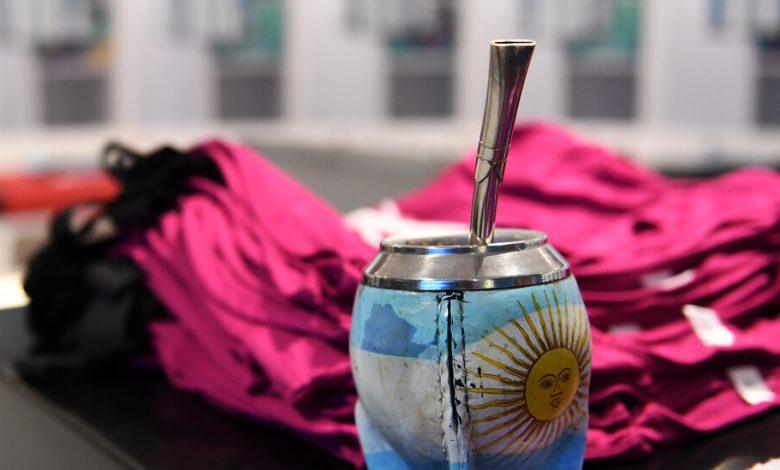What’s Powering Argentina at the World Cup? 1,100 Pounds of Yerba Mate.

DOHA, Qatar — Yerba mate is not, to be fair, for everyone.
A strong and often bitter herbal infusion brewed hot or cold from the leaves of a plant native to South America, yerba mate is popular in Paraguay, Uruguay, Brazil and Argentina. Some of the best soccer players in the world hail from that region and swear by it, and they have spread it around the world through their club teams. The World Cup in Qatar, though, raised some logistical and supply challenges, not least of which was: Where would devotees find yerba mate in the Gulf?
So they came prepared. Brazil’s national team, which has a few mate drinkers, brought 26 pounds of it to Qatar, a team official said. Uruguay’s squad packed about 530 pounds. But it was Argentina, which will face Croatia in the semifinals on Tuesday fully expecting to extend its stay through Sunday’s final, that topped them all. To ensure that the roughly 75 members of its traveling party — players, coaches, trainers and the rest — would have a steady supply of a drink they consider essential, Argentina’s team hauled a whopping 1,100 pounds of yerba mate to Qatar.
“It has caffeine,” Argentine midfielder Alexis Mac Allister said in Spanish while explaining why he consumed so much of the drink that some have likened to a stronger green tea. “But I drink it more than anything to bring us together.”
A spokesman for Argentina’s national team, Nicolás Novello, said the team brought different types to suit everyone’s taste: yerba mate with stems (a milder taste), without stems (a stronger, more bitter taste) and with herbs (for other flavors). Observers said nearly everyone, including the team’s star, Lionel Messi, was drinking it; the team’s devotion to the drink was clear every time it unloaded its team bus, and after matches, a handful of players would carry out the traditional mate essentials: a cup made of a hollow gourd, its accompanying straw and a thermos of hot water.
Drinking mate is so commonplace within the Argentine and Uruguayan teams, in particular, that the latter made the thermos, known as Botija in Spanish, its official mascot. A large blue mascot’s outfit even made it to Qatar, where it struggled to fit through the turnstiles of the metro system in Doha.
“When I played in Argentina, a nutritionist used to say mate hydrates you,” said Sebastián Driussi, a midfielder for Austin F.C. in Major League Soccer. Driussi represented Argentina at the youth level internationally and spent three years with the popular Argentine club River Plate. “I don’t know, but it’s like water for us. Before a game, in the locker room, everyone is drinking it all the time. There is no schedule or bad time to have mate. Us in Argentina, we say that mate makes friendships.”
A Brief Guide to the 2022 World Cup
What is the World Cup? The quadrennial event pits the best national soccer teams against each other for the title of world champion. Here’s a primer to the 2022 men’s tournament:
Where is it being held? This year’s host is Qatar, which in 2010 beat the United States and Japan to win the right to hold the tournament. Whether that was an honest competition remains in dispute.
When is it? The tournament opened on Nov. 20, when Qatar played Ecuador. Over the two weeks that follow, four games will be played on most days. The tournament ends with the final on Dec. 18.
Is a winter World Cup normal? No. The World Cup usually takes place in July. But in 2015, FIFA concluded that the summer temperatures in Qatar might have unpleasant consequences and agreed to move the tournament to the relatively bearable months of November and December.
How many teams are competing? Thirty-two. Qatar qualified automatically as the host, and after years of matches, the other 31 teams earned the right to come and play. Meet the teams here.
How does the tournament work? The 32 teams are divided into eight groups of four. In the opening stage, each team plays all the other teams in its group once. The top two finishers in each group advance to the round of 16. After that, the World Cup is a straight knockout tournament.
How can I watch the World Cup in the U.S.? The tournament will be broadcast on Fox and FS1 in English, and on Telemundo in Spanish. You can livestream it on Peacock, or on streaming services that carry Fox and FS1. Here’s how to watch every match.
When will the games take place? Qatar is three hours ahead of London, eight hours ahead of New York and 11 hours ahead of Los Angeles. That means there will be predawn kickoffs on the East Coast of the United States for some games, and midafternoon starts for 10 p.m. games in Qatar.
Got more questions? We’ve got more answers here.
Juan José Szychowski, the president of the National Institute of Yerba Mate in Argentina, said there is an art to perfecting the brew, with every drinker preferring slightly different variations, from sweet to bitter, hot to cold.
“If you start drinking mate, you won’t stop,” Szychowski said in a telephone interview. “It’s more than just a custom. When someone comes over, we tell them, ‘You should have some mate.’ It’s sharing and something social and good for your health.”
Szychowski said mate, which was originally consumed by the region’s Indigenous residents before it was spread by Jesuit missionaries, contains polyphenols, a compound that has antioxidant properties. Some studies, he added, have suggested that the beverage can have a positive effect on health.
The influence, and the example, of mate-drinking players from South America like Messi, Uruguay’s Luis Suárez and Brazil’s Neymar — who used to be club teammates at Barcelona — have led other players to adopt the practice.
Antoine Griezmann, a fixture in the France team that will play in the semifinals on Wednesday, took up the habit after befriending the Uruguayan players Cristian Rodríguez and José María Giménez when they were teammates at Atlético Madrid. Griezmann has said that he now drinks it daily. Another French star, Paul Pogba, said in 2018 that he got hooked on mate after one of his Manchester United teammates at the time — Marcos Rojo, an Argentine — gave him some of his own infusion.
“It’s perfect,” Pogba told an Argentine television channel. “I loved it.”
Szychowski called soccer players the best yerba mate ambassadors around the world, before noting that Pope Francis, an Argentine, is also known to enjoy a cup.
Not every player, though, is a fan of the taste that some have called too bitter, too herbaceous, too earthy. (Experts advised beginners to start with a sweet mate.) Walker Zimmerman, a defender on the United States team that was eliminated from the World Cup in the round of 16, said two of his Argentine teammates at F.C. Dallas years ago — Maximiliano Urruti and Mauro Díaz — introduced him to mate, but he admitted, “I don’t think I’d ever get into it on my own.”
Lisandro López, a former Argentina defender, said not everyone was used to him nursing his mate through a straw when he played in Portugal. “A lot of the time — and I lived in Lisbon for four years — I went to a plaza to drink mate and people looked at me weird, like you’re doing drugs or something,” López said.
Luis Hernández, the former Mexican striker, said his palate couldn’t quite get used to the taste when he spent a season at Boca Juniors in Argentina. While everyone else on the team drank mate, he said, he was the lone holdout.
“I prefer a good coffee than a cup of mate,” Hernández said, adding later with a chuckle, “They say it helps them? But mate doesn’t help you score goals.”



